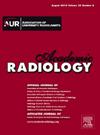用于评估脑膜瘤等级和增殖活性的高级弥散加权磁共振成像模型直方图分析。
IF 3.8
2区 医学
Q1 RADIOLOGY, NUCLEAR MEDICINE & MEDICAL IMAGING
引用次数: 0
摘要
理由和目标:探讨弥散张量成像(DTI)、弥散峰度成像(DKI)、神经元取向弥散和密度成像(NODDI)以及平均表观传播者(MAP)磁共振成像直方图分析在评估脑膜瘤分级和增殖活性方面的价值:前瞻性纳入 134 例脑膜瘤患者,对其进行磁共振弥散成像检查。从多个功能图中提取全肿瘤直方图参数。采用 Mann-Whitney U 检验比较高分级和低分级脑膜瘤的直方图参数。采用接收者操作特征曲线(ROC)和多元逻辑回归分析评估诊断效果。分析了直方图参数与 Ki-67 指数之间的相关性。通过独立验证集(n = 33)进一步验证了扩散模型:结果:在单一直方图参数中,NODDI-ISOVF(各向同性体积分数)的方差在脑膜瘤分级中显示出最高的AUC,为0.829。在组合模型中,DKI 模型的诊断效果最好(AUC=0.925)。Delong 检验显示,DKI 组合模型的诊断性能优于 DTI、NODDI 和 MAP 模型(P 结论:DKI 组合模型的诊断性能优于 DTI、NODDI 和 MAP 模型):DTI、DKI、NODDI 和 MAP 的全肿瘤直方图分析有助于评估脑膜瘤的分级和细胞增殖。在脑膜瘤分级方面,DKI 组合模型比 DTI、NODDI 和 MAP 具有更高的诊断准确性。本文章由计算机程序翻译,如有差异,请以英文原文为准。
Histogram Analysis of Advanced Diffusion-weighted MRI Models for Evaluating the Grade and Proliferative Activity of Meningiomas
Rationale and Objectives
To explore the value of diffusion tensor imaging (DTI), diffusion kurtosis imaging (DKI), neurite orientation dispersion and density imaging (NODDI), and mean apparent propagator (MAP) magnetic resonance imaging histogram analysis in evaluating the grade and proliferative activity of meningiomas.
Materials and Methods
A total of 134 meningioma patients were prospectively included and underwent magnetic resonance diffusion imaging. The whole-tumor histogram parameters were extracted from multiple functional maps. Mann-Whitney U test was used to compare the histogram parameters of high- and low-grade meningiomas. The receiver operating characteristic (ROC) curve and multiple logistic regression analysis were used to evaluate the diagnostic efficacy. The correlation between histogram parameters and the Ki-67 index was analyzed. The diffusion model was further validated with an independently validation set (n = 33).
Results
Among single histogram parameters, the variance of NODDI-ISOVF (isotropic volume fraction) showed the highest AUC of 0.829 in grading meningiomas. For the combined models, the DKI model had the best performance in the diagnosis (AUC=0.925). Delong test showed the DKI combined model showed superior diagnostic performance to those of DTI, NODDI and MAP models (P < 0.05 for all). Moreover, moderate to weak correlations were found between various diffusion parameters and the Ki-67 labeling index (rho=0.20–0.45, P < 0.05 for all). In the validation set, the DKI model still showed higher performance (AUC, 0.85) than other diffusion models, thus demonstrating robustness.
Conclusions
Whole-tumor histogram analyses of DTI, DKI, NODDI, and MAP are useful for evaluating the grade and cellular proliferation of meningiomas. DKI combined model has higher diagnostic accuracy than DTI, NODDI and MAP in meningioma grading.
求助全文
通过发布文献求助,成功后即可免费获取论文全文。
去求助
来源期刊

Academic Radiology
医学-核医学
CiteScore
7.60
自引率
10.40%
发文量
432
审稿时长
18 days
期刊介绍:
Academic Radiology publishes original reports of clinical and laboratory investigations in diagnostic imaging, the diagnostic use of radioactive isotopes, computed tomography, positron emission tomography, magnetic resonance imaging, ultrasound, digital subtraction angiography, image-guided interventions and related techniques. It also includes brief technical reports describing original observations, techniques, and instrumental developments; state-of-the-art reports on clinical issues, new technology and other topics of current medical importance; meta-analyses; scientific studies and opinions on radiologic education; and letters to the Editor.
 求助内容:
求助内容: 应助结果提醒方式:
应助结果提醒方式:


